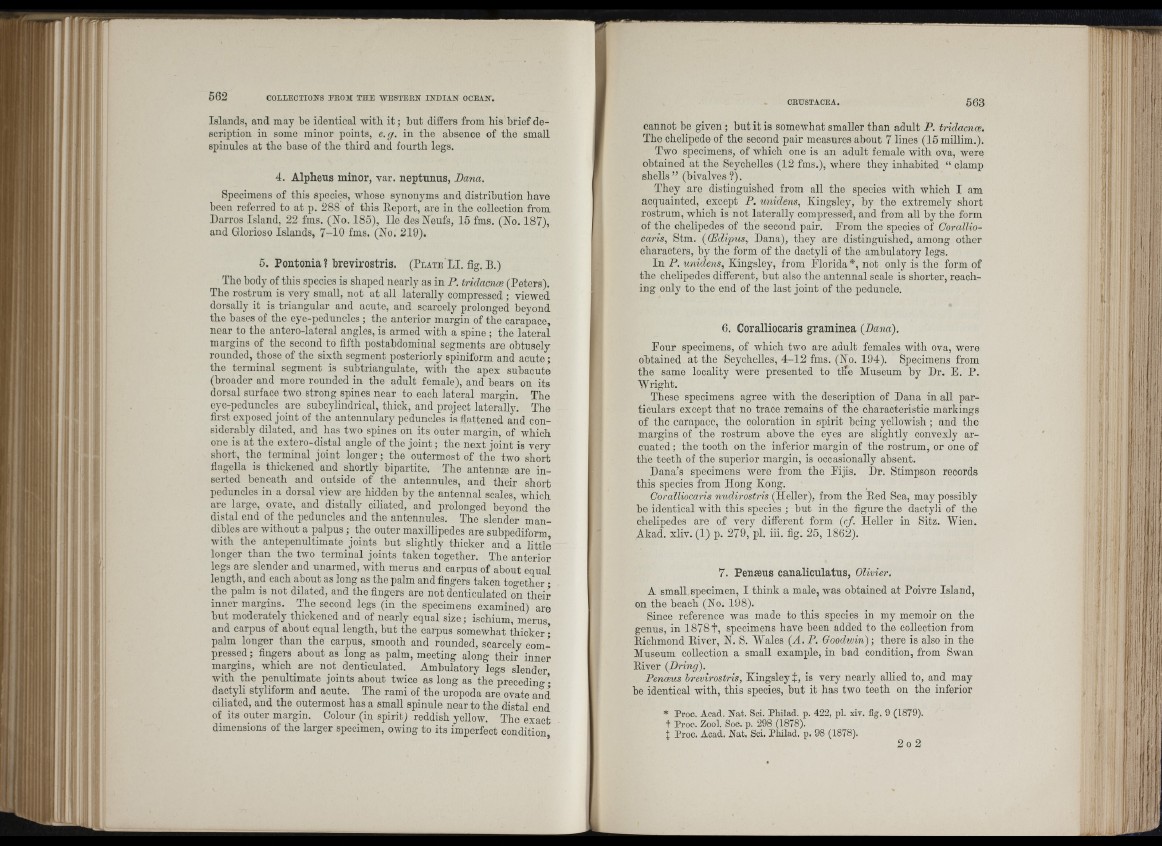
Islands, and may be identical witb i t ; but differs from bis brief description
ill some minor points, e.g. in tbe absence of tbe small
spinules at tbo base of tbe tbird and fourtb legs.
4. Alpbeus minor, var. neptunus, Dana.
Specimens of tbis species, wbose synonyma and distribution bave
been referred to at p. 288 of tbis Beport, are in tbe collection from
Darros Island, 22 fms. (No. 185), He des Neufs, 15 fms. (No. 187),
and Glorioso Islands, 7 -10 fms. (No. 219).
< I
Ji i
5. Pontonia ? brevirostris. (P late LI. fig. B.)
Tbo body of tbis species is shaped nearly as in P. tridacnæ (Peters).
Tbe rostrum is very small, not at all laterally compressed ; viewed
dorsally it is triangular and acute, and scarcely prolonged beyond
tbe bases of tbe eye-pedimclcs ; tbe anterior margin of tbe carapace,
near to tbe antero-lateral angles, is armed witb a spine ; the lateral
margins of tbe second to fifth postabdominal segments are obtusely
rounded, those of the sixth segment posteriorly spiniform and acute ;
the terminal segment is subtriangulate, with tbo apex suhacute
(broader and more rounded in the adult female), and bears on its
dorsal surface two strong spines near to each lateral margin. The
eye-pednncles are subcylindrical, thick, and project laterally. Tbe
first exposed joint of the antennulary peduncles is flattened and considerably
dilated, and has two spines on its outer margin, of wbicb
one is at tbe extero-distal angle of the jo in t; tbe next joint is very
short, tho terminal joint longer; the outermost of the two short
flagella is thickened and shortly bipartite. The antennæ are inserted
beneath and outside of the antennules, and their short
peduncles in a dorsal view are bidden by tbe antennal scales, which
are large, ovate, and distally ciliated, and prolonged beyond tbe
distal end of tbe peduncles and tbe antennules. Tbe slender mandibles
are without a palpus ; tbe outer maxillipedes are subpediform
witb the antepenultimate joints but slightly thicker and a little
longer than the two terminal joints taken together. Tbe anterior
legs are slender and unarmed, witb merus and carpus of about equal
length, and each about as long as tbe palm and fingers taken together •
the palm is not dilated, and the fingers are not denticulated on tbeir
inner margius. Tbe second legs (in tbe specimens examined) are
but moderately thickened and of nearly equal size; ischium, merus
and carpus of about equal length, but the carpus somewhat thicker ^
palm longer than the carpus, smooth and rounded, scarcely com-j
pressed ; fingers about as long as palm, meeting along tbeir inner
margins, wbicb are not denticulated. Ambulatory legs slender
witb tbe penultimate joints about twice as long as the precedino-’
dactyli styliform and acute. Tbe rami of the uropoda are ovate aéd
ciliated, and tbe outermost has a small spinule near to tbe distal end
of its outer margin. Colour (in spirit) reddish yellow. The exact
dimensions of tbe larger specimen, owing to its imperfect condition
cannot be given ; but it is somewhat smaller than adult P. tridacnæ.
Tbe chelipede of tbe second pair measures about 7 lines (15 millim.).
Two specimens, of which one is an adult female with ova, were
obtained at the Seychelles (12 fms.), where they inhabited “ clamp
shells ” (bivalves ?).
They arc distiaguished from all tbe species witb which I am
acquainted, except P. unidens, Kingsley, by the extremely short
rostrum, which is not laterally compressed, and from all by tbe form
of tbe chelipedes of tbe second pair. Prom the species of Coralliocaris,
Stm. (OEdipus, Lana), they are distinguished, among other
characters, by tbe form of the dactyli of tbe ambulatory legs.
In P. unidens, Kingsley, from Florida*, not only is the form of
tbe chelipedes different, but also tbe antennal scale is shorter, reaching
ouly to the end of tbe last joint of tbe peduncle.
6. Coralliocaris graminea (Dana).
Four specimens, of which two are adult females witb ova, were
obtained at the Seychelles, 4 -1 2 fms. (No. 194). Specimens from
the same locality were presented to tlie Museum by Dr. E. P.
Wright.
These specimens agree witb tbe description of Dana in all particulars
except that no trace remains of tbe characteristic markings
of tbe carapace, the coloration in spirit being yellowish; and the
margins of the rostrum above tbe eyes are slightly convexly arcuated
; the tooth on the inferior margin of the rostrum, or one of
tbe teeth of the superior margin, is occasionally absent.
Dana’s specimens were from tbe Eijis. Dr. Stimpson records
this species from Hong Kong.
Coralliocaris nudirostris (Heller), from tbe Bed Sea, may possibly
be identical witb this species ; but in tbe figure tbe dactyli of the
chelipedes are of very different form {cf. Heller in Sitz. Wien.
Akad. xliv. (1) p. 279, pi. iii. fig. 25, 1862).
7. Penæus canaliculatus, Olivier.
A small specimen, I think a male, was obtained at Poivre Island,
on the beach (No. 198).
Since reference was made to tbis species in my memoir on the
genus, in 18781, specimens bave been added to tbe collection from
Bicbmond Biver, N. S. Wales {A. P. Goodtuin) ; there is also in tbe
Museum collection a small example, in bad condition, from Swan
Biver (Dring).
Penæus brevirostris, Kingsley], is very nearly allied to, and may
be identical witb, this species, but it has two teeth on tbe inferior
* Proc. Acad. Nat. Sci. Philad. p. 422, pi. xiv. fig. 9 (1879).
t Proc. Zool. Soc. p. 298 (1878).
Î Proc. Acad. Nat. Sci. Philad. p. 98 (1878).
If
;I -' t]'
h■'M
f'
■
Ui'
I' UI,- -'!-I
I Í ■
I. '
I I ' !
I : ■»' : te